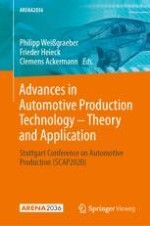2021 | OriginalPaper | Chapter
A Novel Approach to Generate Assembly Instructions Automatically from CAD Models
Authors : Alexander Neb, Johannes Scholz
Published in: Advances in Automotive Production Technology – Theory and Application
Publisher: Springer Berlin Heidelberg
Activate our intelligent search to find suitable subject content or patents.
Select sections of text to find matching patents with Artificial Intelligence. powered by
Select sections of text to find additional relevant content using AI-assisted search. powered by
